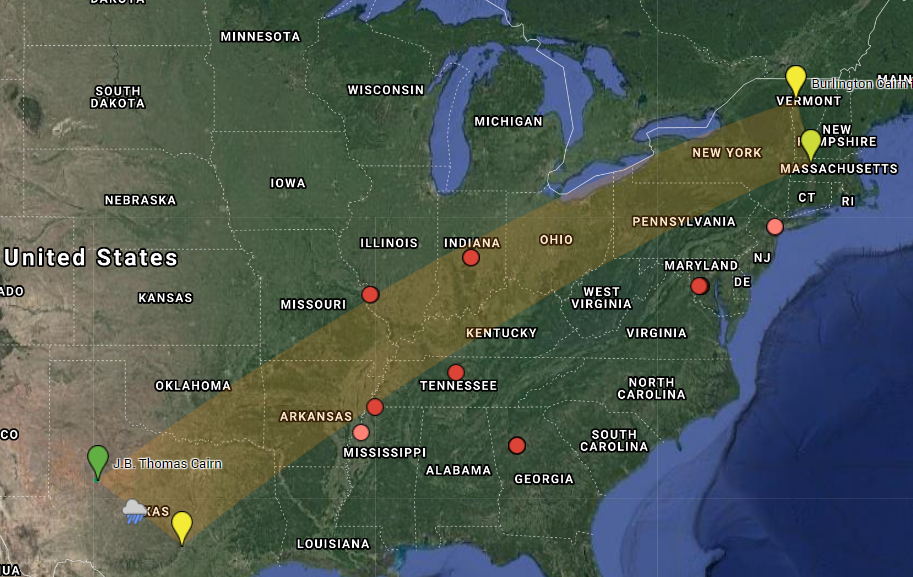
There are few things in this world I enjoy more than cooking and eating food. Gun to my head, if you asked me whether I’d rather engage in a night of…
Kitchen Cultus: Nom Nom Nom

There are few things in this world I enjoy more than cooking and eating food. Gun to my head, if you asked me whether I’d rather engage in a night of…
Kitchen Cultus: Nom Nom Nom
I need to up my game. Here’s an article about “Spiritual Mapping”, a technique being employed by some Imperial “Christian” sects to pick up colonialism where Catholicism left off. Many thanks to Marcus Herminius for drawing my attention to it.
To combat the apparent onslaught of Evangelicals on land spirits (no kidding, look up Spiritual Mapping), today I will be giving offerings to the …
Far Over the Muggy Hilltops Warm
Animism in “The Babushkas of Chernobyl” from A Forest Door:
Just watched a fascinating documentary called The Babushkas of Chernobyl, about the handful of old women still living in villages within the …
Homeland
Animism is inherently a belief in consciousnesses we cannot reliably perceive in ways testable via the Scientific Method. When someone tries to force animism into the mold of scientism and deterministic materialism, they are missing the art for the paint.
“The Victorian anthropologist E.B. Tylor defined animism in terms of a ‘belief in souls or spirits,’ interpreted as a theoretical construct designed …
The problem with the new animism
Hm, I’m feeling bloggier (is that a word?) than normal it seems lately, and particularly on the subject of plants. I guess it’s just that time of …
Beyond Plant Names
There is a pretty popular video game named Death Stranding that centers around the concept of tying places together via a “Chiral Network” that routes information through the Otherworld. While the game is fiction, the core esoteric concept is not.
Starting in the early 2010s, a good chunk of my landwork involved “spirit bridges”. These are point-to-point connections constructed using an exchange of materials, usually stone.
Originally, my spirit bridges were tiny, no more than a few hundred yards- usually much less. The rationale was to permit spiritlife to move more freely around their environment, unhampered by humanmade obstacles.
For example, connecting two sides of a road for the benefit of very small entities who previously had unfettered access to each other. The idea is analogous to “wildlife crossings“- tunnels or bridges erected to help biological wildlife move from place to place.
Then, in 2012, a friend and I set out to address a blockage in Vermont that was inhibiting the attempts of healthy spiritlife from the Lake Champlain watershed to help heal some of “The Sick” that was infecting the Connecticut River watershed.
While the physical crossing was small, and should have been easy to bridge, the entire area was under the control of a hostile, unidentified Power that drove us off. Clearly said Being did not want the traffic running through Their territory and was likely the cause of the break in the first place. While I’m now fairly certain of the Entity’s identity, there wasn’t much I could do about His decisions.
This led me to start working on longer-range spirit bridges, ones that were more complicated to erect and maintain. These were built on the same esoteric foundations, but would be consecrated to and mediated by Holy Powers for safety reasons.
Between 2013 and 2014, I erected four spirit bridge cairns:

By the end of 2015, between life stresses, vandals, and just plain entropy the strain of maintaining just the Austin cairn by myself became too much. I convinced myself that the system wasn’t actually working and stopped.
At the end of 2015, Hideo Kojima began work on Death Stranding.
Do I think certain Gods made Kojima make this game so I’d realize the system wasn’t a failure?
No.
But I am more and more convinced that Someone(s) wove meaning into it, something Holy Powers have been doing for centuries. And I don’t think I’m the sole target audience.
Remember, one of the big problems that led me to abandon the Spirit Bridges Program (ooh, now it sounds important!) was the strain of doing it myself. This is in part my own shortcomings. I’ve always been a solo operative and struggle to involve others in my work. However, part of it was also an operational security fear.
As mentioned elsewhere, landwork has been both a tool of conquest and of resistance. Being more open about the spirit bridge technology meant increasing the risk of sabotage. It also increased the potential that it could be hijacked by faiths hostile to our attempts to heal our environment and restore right relations with our spiritlife neighbors.
On the sabotage front, I was clearly overly concerned with secrecy. In vain it turns out, since the Austin cairn kept getting destroyed even without anyone knowing what it was. Had I assistance with maintaining it, perhaps it would still be there. Instead, afraid of sabotage, I tried to do it all myself and it wound up destroyed anyway.
Of course, the esoteric connection is still there, but it’s much weaker without regular maintenance.
While the plot of Death Stranding focuses on expanding the Chiral Network (technobabble spirit bridges), the actual “core loop” involves strengthening interpersonal connections. This is done explicitly- as you help people, they give you more access to resources, and the like. However, it is also implicit in the game- the more you connect, the more you see evidence of other players in the game world.
For instance, the first time you pass through an area, you might see a ladder or a rope left behind by another player that helps you climb a cliff. The second time, you might see more ladders and a postbox. Each time you cross a section of map you might see more and more features, bridges, charging stations, watchtowers… All of these are structures built by other players to make it easier for them (and you) to traverse the map.
You never see the other players, only their work.
I suspect that this was the point that certain Gods were trying to get across by nudging Kojima’s team throughout the making of Death Stranding:
We are not alone. There are others doing the work.
And we need to connect.
– In Deos Confidimus
Well, I’d been planning to write a little thing about Santa Claus and piety over at America Divine, but then I saw that a Roman Catholic priest had esoterically napalmed a town in rural Louisiana.

Cropdusting an entire town with holy water is a massive re-escalation of Catholic colonialism and it is inviting imitation. I’m sure a number of parishes are already considering something similar.
Unfortunately, many in our society think that holy water is simply a form of well-wishing. They think of “blessing” in the same sense as someone saying “bless you” after a person sneezes. While asking that someone be blessed certainly has a benevolent aspect, blessing has some very specific esoteric functions. Namely, it is a form of sanctification, though much less total than consecration.
The process of sanctification involves asking a Holy Power to bring someone or something closer to Them. Much of what humans do in this regard involves prayer, contemplation, ritual, offerings, and works that align the person mentally, emotionally, and spiritually towards that Divinity so as to invite Their grace. Blessing is the act of requesting that sanctification on behalf of a third party, for example a priest asking blessings upon a parishioner.
Holy water is a fungible means of storing such a blessing and is a used in a number of different faiths worldwide, not just in Catholic Christianity. The exact liturgical process differs but the esoteric foundation is usually similar. Such blessed water is typically used for ritual purification and to bring the faithful closer to their Gods.
Here’s the thing- holy water is NOT generic. Holy water blessed by Asklepios is, on a fundamental level, closer to Him and His nature. Holy water of Yah is closer to Him. Holy water of Isis is closer to Her. Some Gods might be favorably inclined towards those aspersed with water blessed by a colleague, but it’s still an individual consideration. It’s Their choice, not ours.
The spiritual technologies of sanctification and blessing exist only because of the inherent diversity of the Gods and therefore, of Creation. If there was only one God, humans would have no need for holy water- everyone would naturally flow towards That One.
But we do need it. Whichever Gods blessed the holy water are the Gods towards whom the recipients will be drawn. Similarly, holy water can attract spiritlife friendly to or in alignment with those Divinities. It also tends to repel spiritlife inimical to those Gods and their ways.
That repulsion isn’t an absolute, though. The stronger the spiritlife in question, the more likely it is to simply piss them off. Given how angry much of Louisiana’s spiritlife seems, this is probably not a good idea.
Old-school perfume counters were infamous for randomly blasting passers-by with their scents. I don’t remember the film or TV show, but there was a comedy many years ago in which a man goes to a department store to get a gift for his wife and gets sprayed. His wife then suspects him of infidelity because he smells like some other woman’s perfume.
It’s a crude analogy, but holy water is a bit like that- it identifies those blessed with it as aligned with, or even the property of, the God(s) in question.
Thus, blasting a whole area with holy water is a deliberate offensive. It lays claim to that land and everything in it- all of its spiritlife (including humans). It’s quite literally an act of spiritual warfare- a term that proponents of this kind of atrocity are fond of.
I don’t know if modern Roman Catholic priests are taught this aspect of their spiritual tech, but any competent priest should know it. Indeed, much of history involved a great deal of deliberately leveraging spiritual technology for purposes of conquest. Missions, especially the big Spanish ones, served not simply to convert the populace, but to exert esoteric influence over the land itself and the spiritlife thereon.
That’s not to say that a priest blessing his parishioners is bad. My objection is to the indiscriminate nature of the spraying and the willful ignorance of those who think it was an innocent act of kindness. It was not.
It was an act of war and we are caught in the crossfire.
-In Deos Confidimus
Reblogged from Seo Helrune:
“What do re-enchantment, Otherworld ‘seepage’, the ominously named ‘the Storm’, and pilgrimage have in common? They’re all in this rant about restoration!
— Read on seohelrune.com/2018/10/29/restoration-not-reenchantment/“
Reblogged from Melas the Hellene:
How to establish a pagan community? 10 necessary things
http://traditionalpolytheist.com/2018/12/16/how-to-establish-a-pagan-community-10-necessary-things/
— Read on traditionalpolytheist.com/2018/12/16/how-to-establish-a-pagan-community-10-necessary-things/
It’s talking about some of the same issues as “Towns Before Temples”, but in a more checklist-style format.